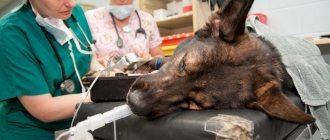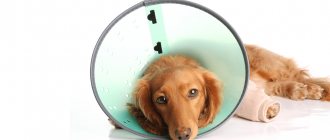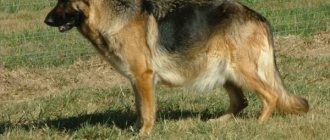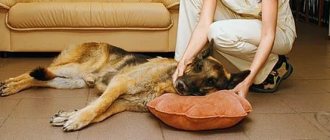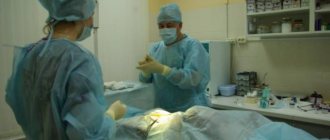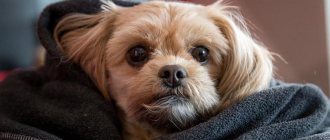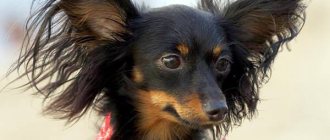The recovery period for a dog after castration begins from the moment it is transported home. Many veterinary institutions practice removing animals from narcotic sleep. Only after this the surgeon gives the dog to the owner with instructions on the rules of postoperative care.
for transporting your dog after castration. The car seat must be covered with waterproof material, for example polyethylene, oilcloth, on top of which a disposable diaper or sterile cotton cloth is placed. Such measures will not allow the car’s upholstery to be damaged, since after anesthesia the animal often experiences spontaneous urination.
Considering that after drug-induced sleep the pets’ body’s thermoregulation is disrupted, the owner should take care of a warm blanket or blanket.
A dog of a decorative or dwarf breed can be transported in a carrier, basket, or box. If the dog is large, then it is more convenient to use the back seat of the car for transportation. While driving, you should avoid sudden acceleration and braking.
The dog may be disoriented in space for 2-10 hours after surgery. Care must be taken to ensure that the animal does not fall from a height and injure itself.
Upon arrival home, the operated dog should be carefully placed in a prepared place . During the first day, it is necessary to keep the dog on a waterproof bedding or disposable diaper. It is advisable to be with your pet continuously in the first hours after castration.
Experienced dog breeders recommend carefully moving the animal to the other side every half hour . Simultaneously with turning over, you should check the litter and replace it, if necessary, with dry litter to avoid hypothermia.
During the first hours, the owner needs to ensure that the animal is in a warm and dry room, without drafts. It is not recommended to organize a temporary bed near a heating radiator. The presence of strangers and other animals in the premises is not desirable.
You can feed your dog only after it has recovered from anesthesia and is able to eat food on its own, usually not earlier than 24 hours after surgery. Force-feeding is strictly prohibited, as it can lead to serious consequences, including the development of aspiration pneumonia and suffocation.
In the first days after castration, portions should be small. The dog should be fed 4-5 times a day with semi-liquid food. Meat (chicken) and fish broths are perfect for these purposes. After 2-3 days, liquid porridge, for example, oatmeal, can be introduced into the diet.
Chicken or quail eggs are suitable as a source of protein and vitamins during the postoperative period. To prevent constipation, the diet should be enriched with lactic acid products - kefir, yogurt. In the first days after castration, dry food should be given only in a soaked form.
In some cases, your pet may vomit after the first meals. Reason: narcotic substances remain in the blood for a long time and negatively affect the motor and secretory functions of the body.
In veterinary practice, it is customary to carry out a course of antibacterial therapy in the postoperative period aimed at preventing the infectious process. The most effective drugs have been those administered by injection, for example, Sinulox, Ceftriaxone, Cobactan. The course of antibacterial support is at least 5 days.
For large animals, a veterinarian may prescribe painkillers in the first days after castration.
the suture after castration of a dog with antiseptic drugs to avoid suppuration. To treat the wound, antiseptics such as chlorhexidine, Aluminspray, Veteritsin-spray are used. In some cases, treatment with Levomekol ointment is prescribed.
Often, a special blanket is used to protect the seam from infection. It should be changed daily . When treating a wound surface, it is convenient to untie the last tapes and move the blanket. After completing the sanitization, the fabric structure can be easily returned to its original position.
In order to prevent gnawing and licking of the postoperative suture, a special collar is put on the animal in the first days after castration . A useful accessory prevents the dog from accessing the wound, which reduces the risk of infection. The collar is removed when the postoperative wound has healed. On average 5-8 days.
During the postoperative period, a weakened pet is not able to fully care for its fur. The dog's appearance becomes disheveled. Long-haired breeds may develop mats. The owner should comb the coat using a sparse comb. It is strictly forbidden to bathe the dog immediately after surgery ; this can only be done after the postoperative sutures have healed.
Changes after castration of a dog:
- The dog became aggressive. There are two reasons for this. First of all, the effect of anesthesia should not be discounted. Drugs negatively affect the functioning of the animal’s brain, which can be accompanied by aggression. Inappropriate dog behavior after surgery is most often observed due to pain. Aggressive behavior is typical for females, since the area of the wound is much larger than during castration of males.
- Fistula as a result of surgery . Infection of a postoperative suture often leads to the development of a ligature fistula. The reason is a violation of the rules of septic and asepsis when processing suture material or its contamination during surgery. A characteristic sign of the disease is inflammation and redness of the tissue around the wound, the appearance of purulent exudate. A fistula can lead to the development of inflammation of the peritoneum and even sepsis.
- Urinary incontinence in a dog after castration . In some cases, after surgical removal of the gonads, complications from the excretory system may develop. Incontinence is more common in large breeds. As a rule, this phenomenon is a consequence of hormonal changes, as a result of which the smooth muscles of the bladder become less sensitive. Drug treatment or surgery can help correct the deficiency.
A dog in a diaper
Having discovered a ligature fistula in a pet, the owner must immediately show it to a veterinarian . To help the animal, a professional removes rotted suture material and carries out antiseptic treatment of tissues. If necessary, the dog is prescribed antibacterial drugs intramuscularly.
- Why doesn't the dog go to the toilet ? Narcotic drugs negatively affect the motor function of the digestive system. As a rule, before the operation the animal was on a starvation diet, and after castration, food intake can be delayed for 2 or even 3 days. Such a long interval often provokes constipation in the dog.
- Correct feeding of semi-liquid food in fractional portions will help eliminate the problem. If necessary, use laxatives or a cleansing enema.
- Why are my eggs swollen? This happens 3-4 days after removal of the gonads in males. Scrotal swelling is a common post-operative reaction of the body and usually goes away on its own. If excessive swelling has not gone down 5-7 days after surgery, then the dog should be shown to a veterinarian.
Unfortunately, after surgery the dog may continue to mark. Castration, as a panacea for unwanted animal behavior, is possible only before puberty. At a later age, if the dog has developed behavioral manners during sexual heat, castration does not always make it possible to rid furniture and belongings of the dog’s marks.
Surgical removal of the gonads inevitably leads to changes in the behavior of dogs after castration . The animal becomes more human-oriented, obedient, and efficient. The operation does not have any effect on the quality of work performed by a service or hunting dog. On the contrary, castrated animals are more amenable to training and coaching, and are less distracted by their fellow animals.
Read more in our article about a dog after castration.
Care in the first days after castration of a dog
Having made a responsible decision to carry out the operation, the owner should know what the dog should be like after castration. Not only the condition of the dog in the postoperative period, but also its future health depends on how competently and carefully the rehabilitation process is organized. In this regard, veterinary specialists, as a rule, give detailed recommendations for caring for a dog after castration.
The owner needs to properly transport the pet from the clinic to its home, take care of proper feeding, carry out antiseptic treatment of the suture and, according to the recommendations of a veterinary specialist, use antibiotics.
Transportation of an animal after surgery
The owner should begin following the advice of professionals already at the stage of transporting the operated pet from a specialized clinic home. Many veterinary institutions practice removing animals from narcotic sleep. Only after this the surgeon gives the furry patient to the owner with instructions on the rules of postoperative care.
You should prepare in advance for transporting your dog after castration. The car seat must be covered with waterproof material, for example polyethylene, oilcloth, on top of which a disposable diaper or sterile cotton cloth is placed. Such measures will not allow the car’s upholstery to be damaged, since after anesthesia the animal often experiences spontaneous urination.
Considering that after drug-induced sleep the pets’ body’s thermoregulation is disrupted, the owner should take care of a warm blanket or blanket. A dog of a decorative or dwarf breed can be transported in a carrier, basket, or box. If the dog is large, then it is more convenient to use the back seat of the car for transportation. While driving, you should avoid sudden acceleration and braking.
The owner of an operated animal should be aware that in the first hours after any anesthesia, uncontrolled movements are possible. The dog may be disoriented in space for 2-10 hours after surgery. In this regard, it is necessary to ensure that the animal does not fall from a height and does not injure itself as a result of unconscious movements.
Upon arrival home, the operated dog should be carefully placed in a prepared place. During the first day, it is necessary to keep the dog on a waterproof bedding or disposable diaper . It is advisable to be with your pet continuously in the first hours after castration.
Experienced dog breeders recommend carefully moving the animal to the other side every half hour. Simultaneously with turning over, you should check the litter and replace it, if necessary, with dry litter to avoid hypothermia.
During the first hours, the owner needs to ensure that the animal is in a warm and dry room, without drafts. It is not recommended to organize a temporary bed near a heating radiator. The presence of strangers and other animals in the premises is not desirable.
We recommend reading about how to transport a dog. From the article you will learn about the general rules for transporting a pet, organizing a trip with a dog by car, bus, plane, rail and bicycle.
And here is more information about why the dog shits everywhere.
Feeding a dog after castration
One of the essential conditions for a successful postoperative period is adherence to a special diet. First of all, the owner should know that the dog can be fed only after it has recovered from anesthesia and can eat food on its own, usually not earlier than 24 hours after the operation. Force-feeding is strictly prohibited, as it can lead to serious consequences, including the development of aspiration pneumonia and suffocation.
In the first days after castration, portions should be small. The dog should be fed 4-5 times a day with semi-liquid food. Meat (chicken) and fish broths are perfect for these purposes. After 2-3 days, liquid porridge, for example, oatmeal, can be introduced into the diet.
Chicken or quail eggs are suitable as a source of protein and vitamins during the postoperative period. To prevent constipation, the diet should be enriched with lactic acid products - kefir, yogurt. If before castration the dog preferred dry food, then in the first days after castration the dog should be given it only in a soaked form.
In some cases, your pet may vomit after the first meals. This phenomenon is due to the fact that narcotic substances remain in the blood for a long time and negatively affect the motor and secretory functions of the body.
Antibiotics in the first days
In veterinary practice, it is customary in the postoperative period to conduct a course of antibacterial therapy aimed at preventing
infectious process. Antibiotics after castration of a dog are usually prescribed by the veterinary surgeon who performed the operation. The most effective drugs have been those administered by injection, for example Sinulox, Ceftriaxone, Cobactan.
The course of antibacterial support is at least 5 days. The dose and duration of antibiotic use depends on the age, type of operation, body weight and individual characteristics of the pet and is calculated in each specific case by the attending physician.
In addition to antibiotics, a veterinarian may prescribe painkillers for large individuals in the first days after castration.
Seam care
A pressing problem during the rehabilitation period is postoperative wound care. Veterinary experts recommend regularly treating the suture after castration of a dog with antiseptic drugs to avoid suppuration. The risk of complications is highest in females, since sterilization is an abdominal operation.
To treat the wound, antiseptics such as chlorhexidine, Aluminspray, Veteritsin-spray are used. In some cases, a veterinarian may prescribe treatment of the seam with Levamekol ointment.
Often, a special blanket is used to protect the seam from infection. It should be changed daily. When treating a wound surface, it is convenient to untie the last tapes and move the blanket. After completing the sanitization, the fabric structure can be easily returned to its original position.
How long to wear a collar
In order to prevent gnawing and licking of the postoperative suture, a special collar is put on the animal in the first days after castration. A useful accessory prevents the dog from accessing the wound, which reduces the risk of infection. The owner often asks the veterinarian how long to wear the collar after castration of the dog.
There are no clear recommendations in this regard. As a rule, the collar is removed when the postoperative wound has healed. On average, this period occurs at 5-8 days.
Caring for your dog's coat after castration
Worried about how the dog looks after castration, the owner often takes care of the condition of its coat. During the postoperative period, a weakened pet is not able to fully care for its fur. The dog's appearance becomes disheveled.
Long-haired breeds may develop mats. The owner should help the animal during this period and comb the fur with a sparse comb. Bathing the dog immediately after surgery is strictly prohibited; this can only be done after the postoperative sutures have healed.
Watch this video on how to care for sutures after surgery:
Dogs after sterilization and castration
Some dogs recover quickly on their own, but there are ways you can make the healing process easier.
What do you need to remember after your dog has been spayed?
After your dog is home from surgery, you may notice that he is disoriented or more depressed than usual. It is not uncommon for a dog to be especially quiet during the first 24 hours after surgery. If for some reason your dog is agitated, you should confine him to space. Especially in the case of females, who have a higher chance of the seams coming apart.
During the recovery process, place your dog in a quiet area with dim lighting. The sleeping place should be comfortable and the temperature in the room should be pleasant. Also, if you have other pets or children, keep them away from your dog. During the recovery period, your dog may experience some confusion and may become aggressive.
The anesthetic effect usually wears off completely after 24 hours. After this period, your dog should behave as normal.
Eating food and water after spaying or neutering
As soon as your dog gets home from the vet, you can offer him some water. First of all, don't let your dog drink too much as this can cause vomiting. When your dog is awake and active, you can offer him a small amount of food (half the normal amount). If your dog is vomiting or refuses to eat at all, don't force it. Wait until the next day and you can offer food again.
One day after surgery, you can offer water and food in the usual quantities. On the first day, your dog's appetite should not be the same as usual. However, if things do not return to normal within the first 48 hours after surgery, you should call your veterinarian.
In addition, it will be better for your pet to continue to eat food for sterilized animals. It contains the necessary substances in the right ratio.
Will the animal be able to go to the toilet normally after surgery?
During the first time after anesthesia, most often several hours, the control of urination and defecation is impaired in animals; the best solution would be to place an absorbent diaper under the pet.
If your dog does not go to the toilet regularly within three days after surgery, you should contact your veterinarian.
Check to see if there is blood in your dog's urine. A small amount may be present in bitches the first day after surgery. If this continues longer or if your dog seems to be in pain, contact your veterinarian.
Animal activity levels after sterilization
Within a day or two of spaying/neutering, your dog should be back to normal. You should still limit your dog's activity for a week after surgery.
Too much activity can cause the stitches to come apart or become inflamed at the surgical site.
How can you help your pet feel calm after surgery?
Limit the areas in your home that your dog has access to. Keep your dog in a closed room or appropriately sized crate when you are unable to control the restraint. The dog must be able to stand up and turn around inside the crate.
If there are steps and if your dog is small, carry him up and down the stairs in your arms.
Always walk your dog on a leash for short periods of time and do not allow him to play rough with other animals or people. Also, don't let your dog jump up or down on the couch.
Changes after castration of a dog
The owner of the operated pet must closely monitor its condition and know what complications and deviations there may be.
Why did you become aggressive?
Often household members are faced with the phenomenon that a dog is aggressive after castration. Veterinary experts explain the strange behavior for two reasons. First of all, the effect of anesthesia should not be discounted. Drugs negatively affect the functioning of the animal’s brain, which can be accompanied by aggression.
Inappropriate dog behavior after surgery is most often observed due to pain. Aggressive behavior is typical for females, since the area of the wound is much larger than during castration of males.
Urinary incontinence in dogs after castration
In some cases, four-legged pets may develop complications from the excretory system after surgical removal of the gonads. Urinary incontinence in a dog after castration, according to the observation of veterinary specialists and experienced breeders, develops more often in large breeds.
As a rule, this phenomenon is a consequence of hormonal changes, as a result of which the smooth muscles of the bladder become less sensitive. Drug treatment or surgery can help correct the deficiency.
Fistula as a result of surgery
Infection of a postoperative suture often leads to the development of a ligature fistula in a dog after castration. The cause of the trouble is a violation of the rules of septic and asepsis when processing suture material during the rehabilitation period or its contamination during surgery.
A characteristic sign of the disease is inflammation and redness of the tissue around the wound, the appearance of purulent exudate. A fistula can lead to the development of inflammation of the peritoneum and even sepsis.
Having discovered a ligature fistula in a pet, the owner must immediately show it to a veterinarian. To help the animal, a professional removes rotted suture material and carries out antiseptic treatment of tissues. If necessary, the dog is prescribed antibacterial drugs intramuscularly.
Watch this video about why to castrate your pet:
Why doesn't the dog go to the toilet?
Often during the rehabilitation period, the owner is faced with the problem that the dog does not go to the toilet after castration. Constipation in this situation is caused by several reasons. First of all, narcotic drugs used during surgery negatively affect the motor function of the digestive system.
As a rule, before the operation the animal was on a starvation diet, and after castration, food intake can be delayed for 2 or even 3 days. Such a long interval often provokes constipation in the dog.
Correct feeding of semi-liquid food in fractional portions will help eliminate the problem. If necessary, a veterinarian will prescribe laxatives or perform a cleansing enema.
Why are my eggs swollen?
On the 3-4th day after removal of the gonads in males, the owner may discover that the dog’s eggs are swollen after castration. Scrotal swelling is a common post-operative reaction of the body and usually goes away on its own. If excessive swelling has not gone down 5-7 days after surgery, then the dog should be shown to a veterinarian.
How does castration affect performance?
Surgical removal of the gonads inevitably leads to changes in the behavior of dogs after castration. The animal becomes more human-oriented, obedient, and efficient. The operation does not have any effect on the quality of work performed by a service or hunting dog. On the contrary, castrated animals are more amenable to training and coaching, and are less distracted by their fellow animals.
We recommend reading about how to choose a protective collar for your dog. From the article you will learn about when and who needs a protective collar, product options and their features, and how to make a collar yourself.
Find out more about caring for your dog's coat here.
After surgery to remove the gonads, the dog needs proper care. First of all, the owner needs to properly transport the large dog from the clinic to home. In the first days after castration, the main attention should be paid to caring for the postoperative suture and dietary nutrition to prevent constipation. If complications or changes in behavior are detected, the animal must be shown to a veterinarian.
Useful video
Watch this video about how to help a dog recover from post-operative anesthesia (care):
Similar articles
- Urinary incontinence in dogs: main causes after...
In male dogs after castration, urinary incontinence practically does not occur in practice. As a rule, it is observed in the first days and weeks after surgery and is explained by the relaxation of the sphincter muscles... Read more - Hernia in a dog: causes of its appearance, including after...
A detected hernia in a dog may require immediate hospitalization. The reasons may be constipation, weakened muscle tone, after surgery and... Read more
- Peritonitis in dogs: signs, symptoms of viral…
Peritonitis can occur in dogs under the influence of internal and external factors. Signs and symptoms of abdominal inflammation - pain when touched, problems... Read more
- Dog recovery after illness: what to feed...
Castration and sterilization. Dogs. ... Owners are often interested in what to feed their dog after a stomach illness. Read more
- A dog after a fracture: how is recovery going...
Usually, after a fracture, a dog requires games and entertainment in the near future. However, for everything to heal well, proper rehabilitation is required, as well as... Read more
What is considered constipation in a dog?
A healthy dog should have bowel movements twice a day. Even a single bowel movement per day should alert the owner. In puppies, this process occurs more often - 5-6 “trips to the toilet.”
What is meant by “constipation” in a dog:
- Having bowel movements twice every three days or the presence of pain during bowel movements can be considered constipation;
- Feces accumulate in the animal’s intestines, which dry out over time and harden, causing discomfort in the animal. They can injure the intestines during defecation;
- Constipation is a common problem in dogs, especially older ones. The disease is also typical for dogs that lead a sedentary lifestyle and eat bones.
